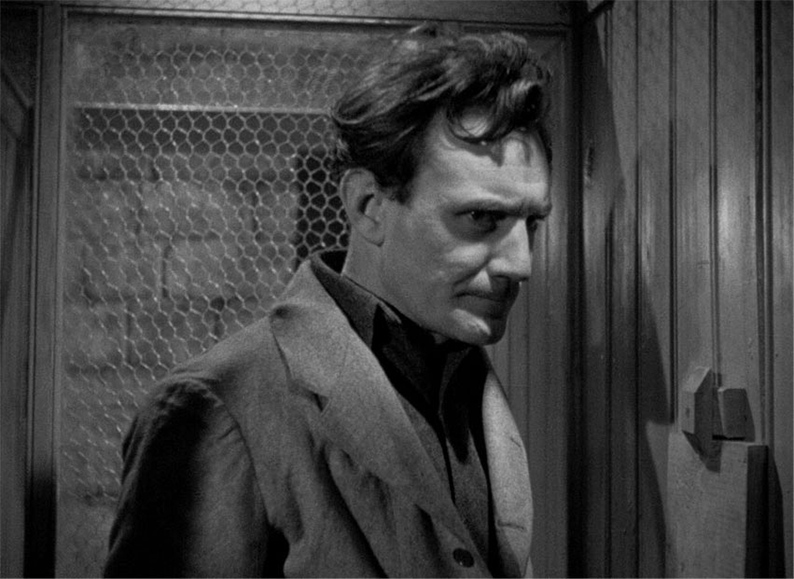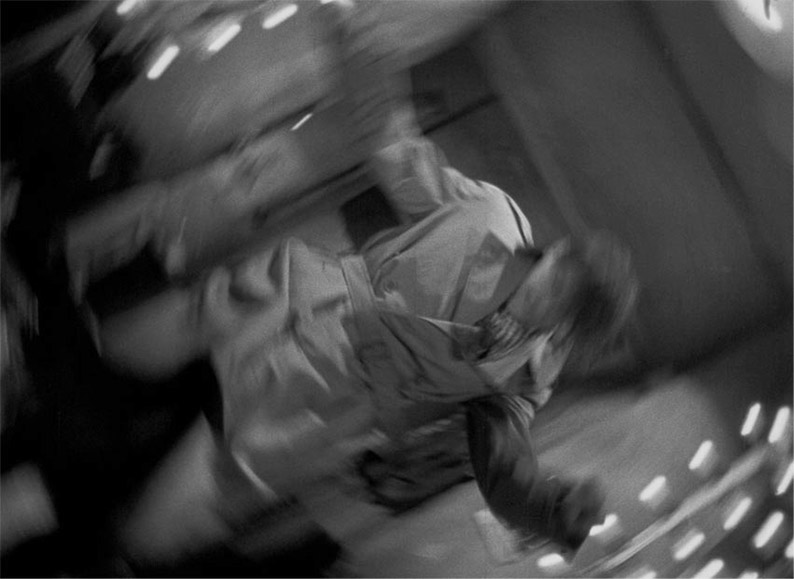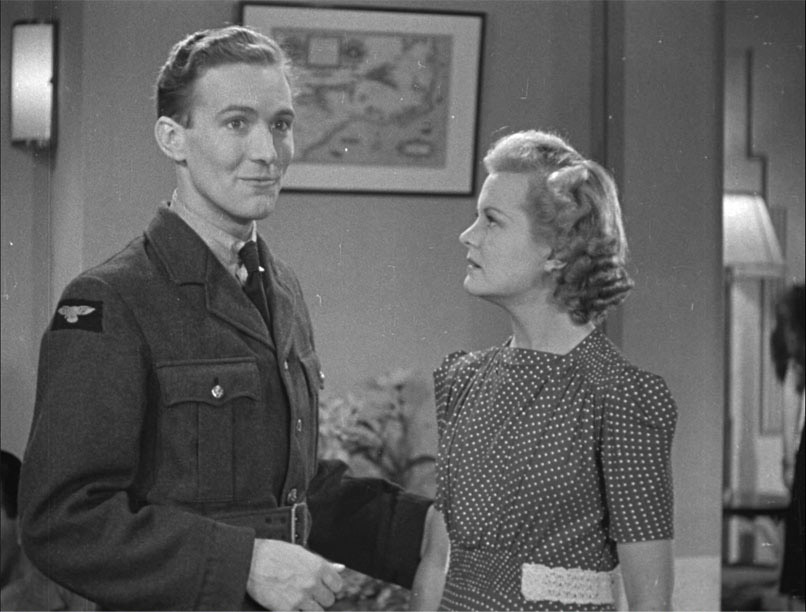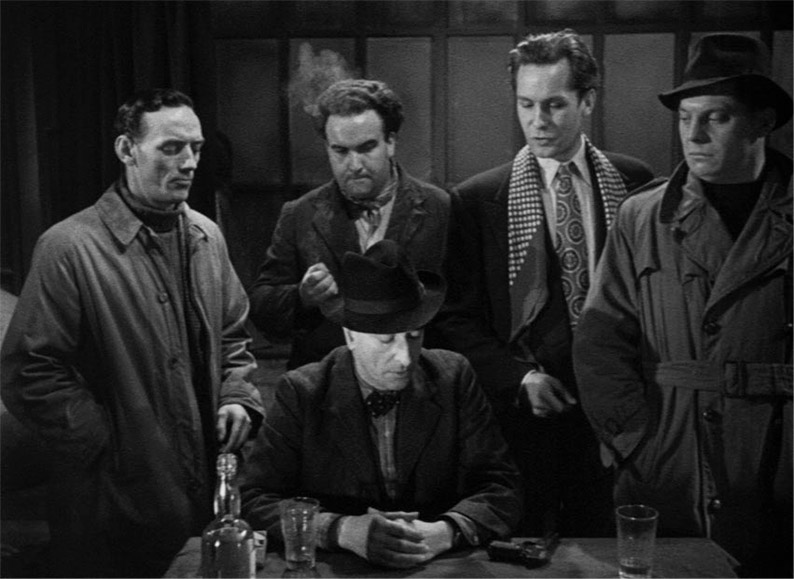| |
"Like certain American films from the 1940s (Force of Evil, Key Largo, Ruthless, Caught and others), Cavalcanti's film – with its hints of Brecht's Three-Penny Opera and Dickens' Oliver Twist – seems to insist that the society emerging from the 'Great War for Democracy' was spawning more than its share of money-hungry, fascistic thugs." |
| |
(History just goes on repeating itself...)
Joanne Laurier, World Socialist Web Site* |
Cinema is an inexhaustible well of watery goodness, one that will not run dry before I'm off to join the choir invisible. One defining delight of writing for this site (Dr. Seuss, beware) is that every now and again, I am sent a review copy of a movie that (a) I've never heard of and (b) I defiantly do no research on before watching it cold. I watched it cold last night. I'm still reeling. Director (Alberto) Cavalcanti is a significantly under appreciated force in British cinema. In my last review of Ad Astra I spoke about intelligence in filmmaking. Here, in 1947, is a director whose work I'm going to associate with the lofty directorial heights of Hitchcock, Powell and Pressburger. This Brazilian born filmmaker went on to do significant work in two other film cultures but even if his Went The Day Well? was my only exposure to his talent, it would be enough. The fact They Made Me A Fugitive is now available on Blu-ray only pushes his stock up further. There is real craft on display here and creative thought that would put a few modern 'auteurs' to some shame. You get the impression that despite the many languages he worked in, his native tongue was the language of cinema.
It's post-war London. A local kingpin keeps a tight grip on his gang as they smuggle goods on the black market via a funeral parlour front. No one would normally choose to look inside a coffin hence the perfect means of transport for cigarettes, nylons and other much in demand items. The kingpin, Narcy (short, wonderfully, for Narcissus) wants to recruit an unemployed, ex-RAF officer Clem Morgan in order to add a bit of class to his operation. Clem sees no harm in making a bit of money on the side until he sees drugs in one of the coffins. He says he'll do the one job and that's it because dealing in drugs is where he draws the line. Immediately, Narcy wants to get back at Clem for his holier than thou attitude. Something happens now that genuinely flummoxes me. Narcy sets the burglar alarm off at the warehouse from which Clem is stealing. Clem manages to get out from the first floor and gets in to Narcy's getaway car. If Narcy wants to stitch up Clem, why wait for him in the car? Now they are both compromised. Police immediately descend on the area (boy, does this occurrence date this film...) and one hapless copper is run over at Narcy's command even though Clem tried to steer the car away. The car crashes and Narcy puts an unconscious Clem in the driver's seat. Clem is naturally blamed and off he goes to prison for fifteen years... Does he get out to get revenge? The movie has 'fugitive' in the title. More on the plot I won't say.

Every aspect of the production deserves praise. First of all, performances like this remind you how potent an actor Trevor Howard could be. It's a shame his later work often overshadows his 40s and 50s roles. Clem Morgan is a character a little lost after leaving the RAF and doing a rather good impression of being rat-arsed, he's happy to become a petty criminal to stay afloat. Howard has always been the quintessential Englishman and having played so many military roles, it's a surprise to read of the ignominious end to his military career. The fact that on this disc, there are two examples of the PR work he did for the RAF cement his Forces-friendly reputation but records apparently show that Howard was booted out of the British Army for mental instability. All grist to the actor's mill. His Clem is confident, able, and morally upstanding despite the petty thievery. He is also something of an action man. The violence in this film is always believable. I'll have a little more to say about that later. His nemesis, Narcy, is played by Griffith Jones with a wide boy panache, a leader's confidence and a sadistic streak that shines cruelly when he thinks women need to be taught a lesson. It's a strong, sturdy performance and we hate him the moment we see him. That he ends up with Clem's girl after Clem is incarcerated is another bone of contention between the men but it is interesting that neither is first billed. Sally Gray gets that honour for playing Sally, the gangster's moll. It seems a little odd as Gray was making a comeback so was hardly a star in the public eye at the time. Maybe she had a great agent. She plays her difficult relationship dilemma very well and in one scene, surely the most unforgettable of the film, all of our hopes are with her...
In They Made Me A Fugitive, you'll find sequences that bring to mind the master directors of the period and one nasty one in particular that I am amazed survived uncut (perhaps it was trimmed – see review of booklet). Narcy (and a nod to Neil Sinyard for reminding us that Narcy not only sounds like 'nasty' but also 'Nazi') goes to see his song and dance girlfriend Sally in her changing room. She was Clem's girl before the killing of the policeman and has visited Clem in prison, something Narcy is not too thrilled about. She's curt with him, sitting removing her make up. He grabs her to a standing position after she taunts him and swipes her across the face. It's fairly shocking but not as shocking as what follows. Seemingly hideously deformed in an adjacent mirror, Narcy is now giving vent to a dangerous, demonic rage. A music cue accompanies Narcy's violence. Another hit sends Sally to the floor and then he kicks her (all directed and edited without actually seeing any actual violent contact). There is significant (intentional?) film damage on Sally's face, laying down in horror at what is being done to her, cut fast, just 12 frames in length before we get to cinematic rage, Cavalcanti style. Out of control Narcy is kicking out and the camera does a full, swift 360-degree move (as if the camera and lens are a screwdriver and 35mm Mitchells were damn heavy) so Narcy appears to be kicking out in as much as a frenzy as how it is being shot. It seems like it may be an optical effect but if so, there'd be a significant zoom in to avoid black areas outside the frame from appearing as the image turned. No sooner have we completed one revolution then we jump cut and go back anti-clockwise again and then the move even speeds up. It is an astonishing evocation of pure animal fury and instantly reminded me of the hallucination scene in The Small Back Room, a modest Powell and Pressburger classic. There's another notable transition that I would love to believe was set up in advance but the editor in me is convinced it was discovered in the cutting room and exploited. Cavalcanti seems to have a playful respect for dissolves, an aspect of filmmaking that is ubiquitous and rarely done well. So many times, a dissolve is used to disguise a bad cut. But here we go from a snooker table shot and the movement of the balls to a wide top shot looking down at several policemen on the search for Clem. The balls do not match the policemen's positions precisely but it's such a visually clever transition I actually laughed when I saw it. Read into it what you may. There's room for plenty of subtextual interpretations of such a cheeky transition but I don't think "Balls to coppers!" is one of them.

In a scene pored over by Neil Sinyard in the extras, Clem makes it, filthy and hungry, to a solitary house in the middle of the country. He finds a preternaturally calm woman playing the piano. Here the film sets up a wholly unbelievable situation and I still can't figure out how Cavalcanti gets away with it. Within the film, it doesn't jar but if you stop and think about it for a moment, it's utterly ludicrous. It rests on the coincidence of a suspected murderer arriving at a house where another murder is required! It's lovely to see Ballard Berkeley as a young man as the police inspector, a face so well known as the resident Major from Fawlty Towers. They Made Me A Fugitive is fast paced, dazzlingly directed with a few jaw-dropping moments and an ending that pays no lip service to the requirements of the genre that good should triumph over evil. The ambiguous ending is all the more delicious for that.
Presented in the 1.37:1 aspect ratio at 1080p HD resolution, They Made Me A Fugitive is a dark film. No, not that kind of dark although it is that kind of dark too. Otto Heller, the renowned cinematographer is very sparing with his lighting to the extent that it is a slightly difficult film to watch in strong daylight. The contrast on a decent monitor is good and the focus quite surprisingly sharp. I have to admit that my judgement on the film's visual quality varies based on the lighting conditions I view it in. Cinema is made for the dark so that's how you should screen it. Characters often move in and out of lit areas, which creatively is more than valid. It's just not that easy to make things out when in shadow. There's no lack of detail per se but you have to work a little harder to perceive the action watched in strong daylight. At night, it plays wonderfully well. The feared grain is hardly noticeable at an optimum viewing distance.
The Lin ear PCM 1.0 mono sound is clear and largely hiss free and the score is effectively strident and bold. There's never any problem discerning dialogue.
There are new and improved English subtitles for the deaf and hard-of-hearing.
The John Player Lecture with Alberto Cavalcanti (1970): archival audio recording of the celebrated director at London's National Film Theatre, including an audience Q&A with fellow filmmakers Michael Balcon, Paul Rotha and Basil Wright (1 hr. 02' 13")
After quite a long introduction by documentary filmmaker, historian and critic John Rotha, the star takes the stage. The then 73-year-old Alberto Cavalcanti (or 'Cav' to his friends) is not very easy to understand because he has a thick Brazilian accent and admits to not having spoken English for twenty years. He reminds us that silent cinema was nothing of the sort with music being played to inspire the actors. In fact in listening I'm only getting about 50 per cent of his contribution, which makes me long for a transcription. The subtitles are for the main feature only. He calls the first colour films "a bunch of very cheap postcards." He warns against the encroachment of the newly established television and how directors' work would be compromised on the TV screen. He even says, bless him, "I hope you understand me?" at 19' 36". Intelligibility was clearly a concern. There's not a heartily affirmative reply but we move on. He rails against what he calls 'Super productions, monstrosities becoming the only possible type of films'. Only the epics, as the argument goes, can compete with the new kid on the block, television. This argument holds no water but cinema then was on the run, the thrust of Cavalcanti's presentation. It ends opening up the audience Q and A after about 36 minutes.

Balcon and Wright join Cavalcanti and Rotha on the stage and it's a giant love in, at a time of great upheaval for British cinema. At the end these men discuss the inevitability of the need for a film school and the worry that churning out creative technicians when production is sporadic at best is born here which fascinates me. Film schools are a mixed blessing. There's a lot to learn about cinema as a craft and art form but students who graduate with a piece of paper saying they are a Cinematographer hit the wall of reality as they join a production on the lowest rung. "Oh, you're a cinematographer! Welcome to the industry. Milk and two sugars and not too strong." No one gets a job on a movie unless they have shown proficiency in their department on a past project. So how do people get a start? By being a runner, an assistant and a heady dose of sheer good luck. There is a ridiculous statistic outlining how many film school graduates are out there with the tiniest fraction of this number of actual jobs available in the real world. This whole extra, pre-VHS, is glued into its time. These are hugely important men in British cinema and although I can't really tell who's who when they're speaking, it's a lively and graceful presentation.
After Effects (2019): appreciation by author and film historian Neil Sinyard (28' 13")
Sinyard takes us through the film with his usual extemporaneous flair for the minutiae of detail on the specific film. I assume he prepares very carefully to deliver such a confident and informative commentary in a standard mid shot talking head. I'll remember this one for him laying out the subtext of the film as a quote from film historian Roger Banville "...a country still suffering the severe after effects of the moral deformities of war."
About the Restoration (2019): the BFI's Kieron Webb discusses the process of restoring the film (13' 20")
There should be a restoration extra feature on all restored older movies. If you have any interest in the preservation of our (and others') cinematic heritage, this kind of detail is fascinating. I started my film career working with celluloid so I have an advantage knowing most of the technical terms. But in this digital age, we have a real chance to preserve older films. Remember, prints struck off an original negative and treated with care would play with hardly any damage at the time of their release. So we are seeing these films as first run audiences did at the time. Kieron Webb's piece to camera is informative and he brings up a rather marvellous dilemma in the one scene I wrote at length about. The second 12 frame shot of Sally receiving Narcy's blows is terribly damaged perhaps beyond repair. It seems to be a different part of the take used of the first close up of her. Webb suggests simply repeating the shot and then he tells us that this damage is consistent on all surviving film materials. Could it be, as I first suspected, that this damage is absolutely intentional (I mean it's only on this one shot) and integral to Cavalcanti's creative wishes? It's the same conclusion Webb comes to and bravely in my view, he and his team left the damage intact. After all, we're seeing a woman being savagely beaten. It makes a perverted sense that a beautiful face would be defaced in this way if the director is making a point. Trust Cavalcanti to use film damage creatively! I would ask for more extras like this considering how important the role of restorer is to our (and the world's) cinematic heritage.
Squaring the Circle (1941): dramatised Royal Air Force training film, starring Trevor Howard in his first known film role (33' 00")
The first thing I noticed on this dramatic presentation is the RAF motto in the front credits: Per Ardva Ad Astra – Through Adversity To The Stars. Nice. The second thing, as alerted to by a caption card, is that this 33 minute film is mute for the first 12 minutes and in these 12 minutes, look who walks in at 43 seconds. Just look at that face. That face eventually somehow turned into Trevor Howard...

Oh my God, this is hilarious. I half expect Michael Palin to pop in and start talking about his ruddy kite downing in the briny. The acting from the youngsters is stage acting (projection and exaggeration) and although I skipped through the 12 minutes (a mute training film from the RAF tests even my completist credentials) the rest of it is pure English ham. The metaphors fall like winking bricks and the sets actually look like sets. The point of the drama is to get low ranking Bill to be more ambitious in his RAF career (presumably to bolster any viewer's enthusiasm to sign up). William's father's big speech at the end is accompanied by, heaven forbid, a dolly track in, don't you know. The best moment in this historically relevant but very silly film is the following line of dialogue, "Gawd, chase my aunt Fanny round the hanger!"
The Aircraft Rocket (1944): extract from a multi-part RAF technical film, featuring Howard (9' 09")
This one features mainly Howard in voice over here but an impossibly young Howard strides in after a minute to brief the chaps on their mission. It's actually quite hard to link Mr. Fresh Face with the actor we all know. And it's worth listening to, in order to hear the way he pronounces 'trajectory' (at 5' 31"). Apart from some startling aerial shots of a few ships under attack, this is not exactly a must-see extra. Well, if you are a fighter pilot who wants to know how to sink merchant ships, it's bally invaluable.
Image gallery: promotional and publicity material
There are 14 black and white stills, 1 Front of House still and 3 poster designs including the American one with the retitled title.

Limited edition exclusive 36-page booklet with a new essay by Nathalie Morris, extracts from Cavalcanti's Film and Reality, a 1970 article on Cavalcanti by Geoffrey Minish, an overview of contemporary critical responses, Anthony Nield on the wartime films of Trevor Howard, and film credits
Morris' essay gives you necessary background information to understand the context of the film. She gives examples of similar films and reminds us that its violence, so artfully conveyed, was still a problem for the censors who demanded minor changes. I'd love to see the signed off full edit before it was shown to the censors... Cavalcanti's own Film and Reality essay extracts... oh, this strikes a very fresh arrow into a sensitive target. He talks about what a producer is and his protestation of the presumption of that full credit without any actual filmmaking by a person (Nat Bronstein) who was just involved in the funding. Slarek knows what I'm talking about but I'm afraid there it has to stay. Let's just say that this particular wound is still open. This is quite a short piece including respect for his screenwriter Noel Langley who also gave us the line "Pay no attention to the man behind the curtain..." cineastes note and a paragraph about puerile censorship. I'd love to read the full piece some time. Minish's 1970 article, Cavalcanti in Paris, fills in the gaps of the career of the itinerant director with his plaintive wish to find a copy of Fugitive from a collector because the original negative had been destroyed. It delights me that his favourite British film of his own work is Went The Day Well? Of the reviews at the time, the Monthly Film Bulletin is unhappy (no shocks there) at the violence. The Observer's verdict is a little less damning while the Philadelphia Inquirer reviewing the re-titled I Became A Criminal is far more open to its merits. Acting Officer Howard by Anthony Nield doesn't mention the ignominious exit from the Army as featured in Howard's Wikipedia page. I make no claims of truth or falsehood for this 'fact'. This is a good piece of background on Howard and amusingly he suggests that because of the nature of his characters in the two RAF films and the main feature, they could be seen as a trilogy. Nice. Restorer Kieron Webb gives us a paragraph on the restoration, which compliments the extra on this disc.
They Made Me A Fugitive is another absolute cracker from Cavalcanti. Yes, there's the grim subject matter and striking violence, but this is an extraordinary film with moments of brilliance and absurdity that cut together makes the film really stand out. It's quite unlike most films of its genre. Great performances, particularly from the hissable villain played by Griffith Jones add to its attractions. Highly recommended for lovers of gritty noir and creative cinema craft.
|